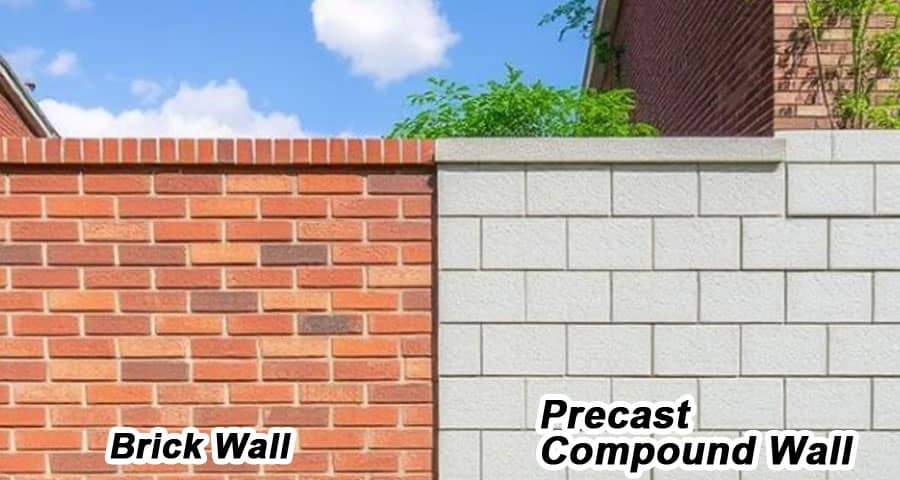Which is Better: Brick Wall or Precast Compound Wall?

When it comes to choosing between a brick wall and a precast compound wall, several factors need to be considered, including durability, cost, installation time, maintenance, and aesthetics. Each type of wall has its own advantages and disadvantages, making the decision dependent on specific project needs.
1. Durability and Strength
Brick Wall Durability
Brick walls are highly durable and robust, often lasting for decades without significant wear and tear. They can withstand extreme weather conditions, fire, and external impacts. The strength of a brick wall depends on the quality of bricks and mortar used. Brick walls are resistant to pests and termites, making them a long-lasting option.
Precast Compound Wall Durability
Precast compound walls are factory-made using reinforced concrete panels, providing considerable strength and resistance. While they are designed to be durable, they may not be as strong as traditional brick walls in extreme conditions such as earthquakes and heavy impacts. However, their resistance to moisture, fire, and pests makes them a reliable choice for many applications.
2. Cost Comparison
Brick Wall Cost
Brick walls require more materials and labor, making them more expensive than precast compound walls. The cost of bricks, cement, sand, and skilled labor can add up significantly. Additionally, the construction process is time-consuming, further increasing labor costs.
Precast Compound Wall Cost
Precast compound walls are cost-effective due to their mass production in factories. The use of pre-molded panels reduces both material waste and labor costs. Installation is faster, leading to lower overall expenses. If you are working with a tight budget, a precast compound wall is the better choice.
3. Installation and Time Efficiency
Brick Wall Installation
Constructing a brick wall is a time-intensive process that requires skilled labor for proper alignment and finishing. A brick wall can take weeks or even months to build, depending on the length and height.
Precast Compound Wall Installation
Precast compound walls can be installed within a few days, as the panels are prefabricated and only need to be assembled on-site. This makes them an excellent option for urgent projects requiring quick enclosure.
4. Maintenance and Repairs
Brick Wall Maintenance
Brick walls require periodic maintenance such as repainting, repointing mortar joints, and repairing cracks that may appear over time due to environmental factors.
Precast Compound Wall Maintenance
Precast walls require minimal maintenance. Since they are made of reinforced concrete, they are less prone to cracks and deterioration. Occasional cleaning and repainting may be necessary, but overall, maintenance is easier and less frequent.
5. Aesthetic Appeal
Brick Wall Aesthetics
Brick walls provide a classic, timeless look and can be customized with different brick styles, colors, and finishes. They blend well with traditional and modern architecture, making them a preferred choice for residential and heritage properties.
Precast Compound Wall Aesthetics
Precast compound walls come in various designs, textures, and patterns, allowing for decorative customization. While they may not offer the same traditional charm as brick walls, they are available in modern and sleek designs that enhance commercial and industrial properties.
6. Environmental Impact
Brick Wall Environmental Impact
The production of bricks involves high energy consumption and carbon emissions due to the kiln-firing process. Additionally, brick construction results in more material wastage on-site.
Precast Compound Wall Environmental Impact
Precast walls are more environmentally friendly as they are manufactured in controlled conditions, reducing material waste. Since installation requires less water and fewer resources, they contribute to sustainable construction practices.
7. Security and Privacy
Brick Wall Security
Brick walls provide excellent security and privacy due to their solid construction and thickness. They are difficult to break through or climb, making them an ideal choice for high-security areas.
Precast Compound Wall Security
Precast walls also provide good security, but they may not be as sturdy as brick walls in extreme conditions. However, additional reinforcements like barbed wire or electric fencing can enhance security.
8. Weather Resistance
Brick Wall Weather Resistance
Brick walls perform well in all climates but may require additional treatment to prevent water absorption and erosion in rainy regions.
Precast Compound Wall Weather Resistance
Precast compound walls are resistant to harsh weather conditions, including rain, heat, and frost, making them a low-maintenance solution for various environments.
Conclusion: Which One Should You Choose?
Both brick walls and precast compound walls have their advantages and are suitable for different applications.
- Choose a brick wall if you prioritize durability, security, and a classic appearance, and if you are willing to invest in a long-term, high-quality solution.
- Opt for a precast compound wall if you need a cost-effective, quick-to-install, and low-maintenance boundary wall solution.
Please watch the following short video for Brick Wall or Precast Compound Wall
